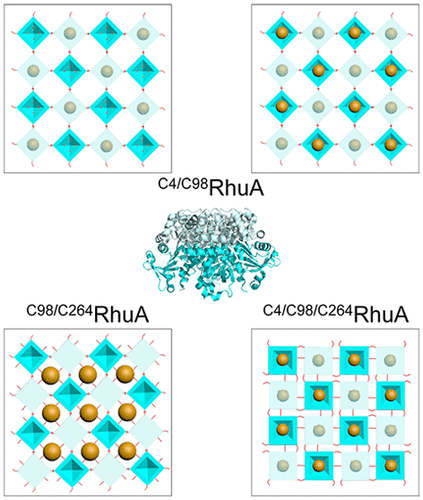当前位置:
X-MOL 学术
›
Nano Lett.
›
论文详情
Our official English website, www.x-mol.net, welcomes your
feedback! (Note: you will need to create a separate account there.)
Precise Fabrication of De Novo Nanoparticle Lattices on Dynamic 2D Protein Crystalline Lattices.
Nano Letters ( IF 9.6 ) Pub Date : 2019-12-30 , DOI: 10.1021/acs.nanolett.9b04574 Mingming Du 1, 2 , Kun Zhou 2 , Xiao Wang 3 , Jianting Zhang 2 , Yejun Zhang 1, 2 , Jinchen Dong 2 , Longlong Wu 3 , Zhi Qiao 3 , Gang Chen 3 , Qiangbin Wang 1, 2, 4
Nano Letters ( IF 9.6 ) Pub Date : 2019-12-30 , DOI: 10.1021/acs.nanolett.9b04574 Mingming Du 1, 2 , Kun Zhou 2 , Xiao Wang 3 , Jianting Zhang 2 , Yejun Zhang 1, 2 , Jinchen Dong 2 , Longlong Wu 3 , Zhi Qiao 3 , Gang Chen 3 , Qiangbin Wang 1, 2, 4
Affiliation

|
The science of protein self-assembly has experienced significant development, from discrete building blocks of self-assembled nanoarchitectures to advanced nanostructures with adaptive functionalities. Despite the prominent achievements in the field, the desire of designing de novo protein-nanoparticle (NP) complexes and constructing dynamic NP systems remains highly challenging. In previous works, l-rhamnulose-1-phosphate aldolase (C98RhuA) tetramers were self-assembled into two-dimensional (2D) lattices via disulfide bond interactions. These interactions provided 2D lattices with high structural quality and a sophisticated assembly mode. In this study, we devised a rational design for RhuA building blocks to fabricate 2D functionalized protein lattices. More importantly, the lattices were used to direct the precise assembly of NPs into highly ordered and diverse nanoarchitectures. These structures can be employed as an excellent tool to adequately verify the self-assembly mode and structural quality of the designed RhuA crystals. The subsequent redesign of RhuA building blocks enabled us to predictably produce a novel protein lattice whose conformational dynamics can be controllably regulated. Thus, a dynamic system of AuNP lattices was achieved. Transmission electron microscopy and small-angle X-ray scattering indicated the presence of these diverse NP lattices. This contribution enables the fabrication of future NP structures in a more programmable manner with more expected properties for potential applications in nanoelectronics and other fields.
中文翻译:

在动态2D蛋白质结晶晶格上精确制备De Novo纳米晶格。
蛋白质自组装科学经历了重要的发展,从自组装纳米结构的离散构建基块到具有自适应功能的先进纳米结构。尽管在该领域取得了显著成就,但设计从头蛋白质-纳米颗粒(NP)复合物和构建动态NP系统的愿望仍然充满挑战。在以前的工作中,l-鼠李糖-1-磷酸醛缩酶(C98RhuA)四聚体通过二硫键相互作用自组装成二维(2D)晶格。这些相互作用为2D晶格提供了高结构质量和复杂的装配模式。在这项研究中,我们为RhuA构件设计了合理的设计,以制造2D功能化的蛋白质晶格。更重要的是,这些晶格用于将NP的精确组装引导到高度有序和多样化的纳米体系结构中。这些结构可以用作出色的工具,以充分验证设计的RhuA晶体的自组装模式和结构质量。随后对RhuA构件的重新设计使我们可以预见地产生一种新的蛋白质晶格,其构象动力学可以被可控地调节。因此,实现了AuNP晶格的动态系统。透射电子显微镜和小角度X射线散射表明存在这些不同的NP晶格。这种贡献使得能够以更可编程的方式制造未来的NP结构,并具有在纳米电子学和其他领域中潜在应用的更多预期特性。这些结构可以用作出色的工具,以充分验证设计的RhuA晶体的自组装模式和结构质量。随后对RhuA构件的重新设计使我们可以预见地产生一种新的蛋白质晶格,其构象动力学可以被可控地调节。因此,实现了AuNP晶格的动态系统。透射电子显微镜和小角度X射线散射表明存在这些不同的NP晶格。这种贡献使得能够以更可编程的方式制造未来的NP结构,并具有在纳米电子学和其他领域中潜在应用的更多预期特性。这些结构可以用作出色的工具,以充分验证设计的RhuA晶体的自组装模式和结构质量。随后对RhuA构件的重新设计使我们可以预见地产生一种新的蛋白质晶格,其构象动力学可以被可控地调节。因此,实现了AuNP晶格的动态系统。透射电子显微镜和小角度X射线散射表明存在这些不同的NP晶格。这种贡献使得能够以更可编程的方式制造未来的NP结构,并具有在纳米电子学和其他领域中潜在应用的更多预期特性。随后对RhuA构件的重新设计使我们可以预见地产生一种新的蛋白质晶格,其构象动力学可以被可控地调节。因此,实现了AuNP晶格的动态系统。透射电子显微镜和小角度X射线散射表明存在这些不同的NP晶格。这种贡献使得能够以更可编程的方式制造未来的NP结构,并具有在纳米电子学和其他领域中潜在应用的更多预期特性。随后对RhuA构件的重新设计使我们可以预见地产生一种新的蛋白质晶格,其构象动力学可以被可控地调节。因此,实现了AuNP晶格的动态系统。透射电子显微镜和小角度X射线散射表明存在这些不同的NP晶格。这种贡献使得能够以更可编程的方式制造未来的NP结构,并具有在纳米电子学和其他领域中潜在应用的更多预期特性。
更新日期:2019-12-30
中文翻译:

在动态2D蛋白质结晶晶格上精确制备De Novo纳米晶格。
蛋白质自组装科学经历了重要的发展,从自组装纳米结构的离散构建基块到具有自适应功能的先进纳米结构。尽管在该领域取得了显著成就,但设计从头蛋白质-纳米颗粒(NP)复合物和构建动态NP系统的愿望仍然充满挑战。在以前的工作中,l-鼠李糖-1-磷酸醛缩酶(C98RhuA)四聚体通过二硫键相互作用自组装成二维(2D)晶格。这些相互作用为2D晶格提供了高结构质量和复杂的装配模式。在这项研究中,我们为RhuA构件设计了合理的设计,以制造2D功能化的蛋白质晶格。更重要的是,这些晶格用于将NP的精确组装引导到高度有序和多样化的纳米体系结构中。这些结构可以用作出色的工具,以充分验证设计的RhuA晶体的自组装模式和结构质量。随后对RhuA构件的重新设计使我们可以预见地产生一种新的蛋白质晶格,其构象动力学可以被可控地调节。因此,实现了AuNP晶格的动态系统。透射电子显微镜和小角度X射线散射表明存在这些不同的NP晶格。这种贡献使得能够以更可编程的方式制造未来的NP结构,并具有在纳米电子学和其他领域中潜在应用的更多预期特性。这些结构可以用作出色的工具,以充分验证设计的RhuA晶体的自组装模式和结构质量。随后对RhuA构件的重新设计使我们可以预见地产生一种新的蛋白质晶格,其构象动力学可以被可控地调节。因此,实现了AuNP晶格的动态系统。透射电子显微镜和小角度X射线散射表明存在这些不同的NP晶格。这种贡献使得能够以更可编程的方式制造未来的NP结构,并具有在纳米电子学和其他领域中潜在应用的更多预期特性。这些结构可以用作出色的工具,以充分验证设计的RhuA晶体的自组装模式和结构质量。随后对RhuA构件的重新设计使我们可以预见地产生一种新的蛋白质晶格,其构象动力学可以被可控地调节。因此,实现了AuNP晶格的动态系统。透射电子显微镜和小角度X射线散射表明存在这些不同的NP晶格。这种贡献使得能够以更可编程的方式制造未来的NP结构,并具有在纳米电子学和其他领域中潜在应用的更多预期特性。随后对RhuA构件的重新设计使我们可以预见地产生一种新的蛋白质晶格,其构象动力学可以被可控地调节。因此,实现了AuNP晶格的动态系统。透射电子显微镜和小角度X射线散射表明存在这些不同的NP晶格。这种贡献使得能够以更可编程的方式制造未来的NP结构,并具有在纳米电子学和其他领域中潜在应用的更多预期特性。随后对RhuA构件的重新设计使我们可以预见地产生一种新的蛋白质晶格,其构象动力学可以被可控地调节。因此,实现了AuNP晶格的动态系统。透射电子显微镜和小角度X射线散射表明存在这些不同的NP晶格。这种贡献使得能够以更可编程的方式制造未来的NP结构,并具有在纳米电子学和其他领域中潜在应用的更多预期特性。









































 京公网安备 11010802027423号
京公网安备 11010802027423号